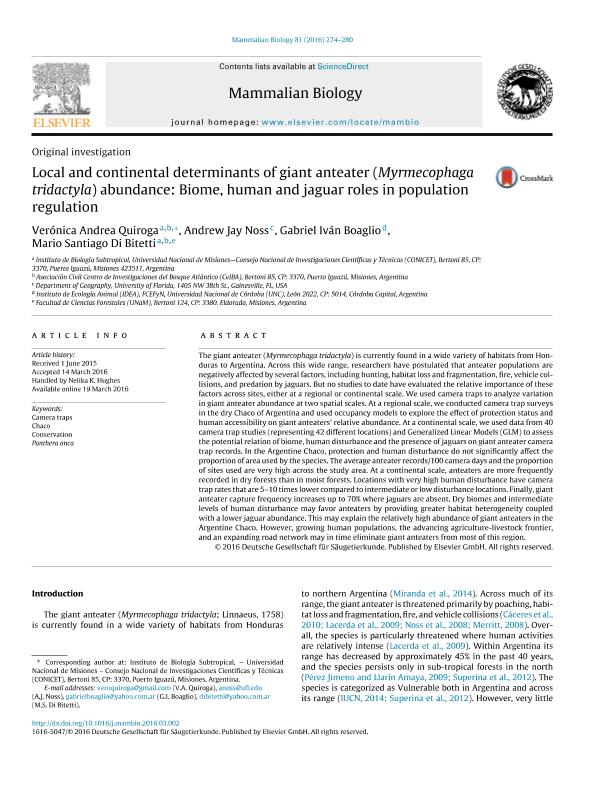Artículo
Local and continental determinants of giant anteater (Myrmecophaga tridactyla) abundance: Biome, human and jaguar roles in population regulation
Fecha de publicación:
19/03/2016
Editorial:
Elsevier Gmbh
Revista:
Mammalian Biology
ISSN:
1616-5047
Idioma:
Inglés
Tipo de recurso:
Artículo publicado
Clasificación temática:
Resumen
The giant anteater (Myrmecophaga tridactyla) is currently found in a wide variety of habitats from Honduras to Argentina. Across this wide range, researchers have postulated that anteater populations arenegatively affected by several factors, including hunting, habitat loss and fragmentation, fire, vehicle collisions, and predation by jaguars. But no studies to date have evaluated the relative importance of thesefactors across sites, either at a regional or continental scale. We used camera traps to analyze variationin giant anteater abundance at two spatial scales. At a regional scale, we conducted camera trap surveysin the dry Chaco of Argentina and used occupancy models to explore the effect of protection status andhuman accessibility on giant anteaters? relative abundance. At a continental scale, we used data from 40camera trap studies (representing 42 different locations) and Generalized Linear Models (GLM) to assessthe potential relation of biome, human disturbance and the presence of jaguars on giant anteater cameratrap records. In the Argentine Chaco, protection and human disturbance do not significantly affect theproportion of area used by the species. The average anteater records/100 camera days and the proportionof sites used are very high across the study area. At a continental scale, anteaters are more frequentlyrecorded in dry forests than in moist forests. Locations with very high human disturbance have cameratrap rates that are 5?10 times lower compared to intermediate or low disturbance locations. Finally, giantanteater capture frequency increases up to 70% where jaguars are absent. Dry biomes and intermediatelevels of human disturbance may favor anteaters by providing greater habitat heterogeneity coupledwith a lower jaguar abundance. This may explain the relatively high abundance of giant anteaters in theArgentine Chaco. However, growing human populations, the advancing agriculture-livestock frontier,and an expanding road network may in time eliminate giant anteaters from most of this region.
Palabras clave:
Camera Traps
,
Chaco
,
Conservation
,
Panthera Onca
Archivos asociados
Licencia
Identificadores
Colecciones
Articulos(IBS)
Articulos de INSTITUTO DE BIOLOGIA SUBTROPICAL
Articulos de INSTITUTO DE BIOLOGIA SUBTROPICAL
Articulos(IDEA)
Articulos de INSTITUTO DE DIVERSIDAD Y ECOLOGIA ANIMAL
Articulos de INSTITUTO DE DIVERSIDAD Y ECOLOGIA ANIMAL
Citación
Quiroga, Verónica Andrea; Noss, Andrew Jay; Boaglio, Gabriel Ivan; Di Bitetti, Mario Santiago; Local and continental determinants of giant anteater (Myrmecophaga tridactyla) abundance: Biome, human and jaguar roles in population regulation; Elsevier Gmbh; Mammalian Biology; 81; 3; 19-3-2016; 274-280
Compartir
Altmétricas




